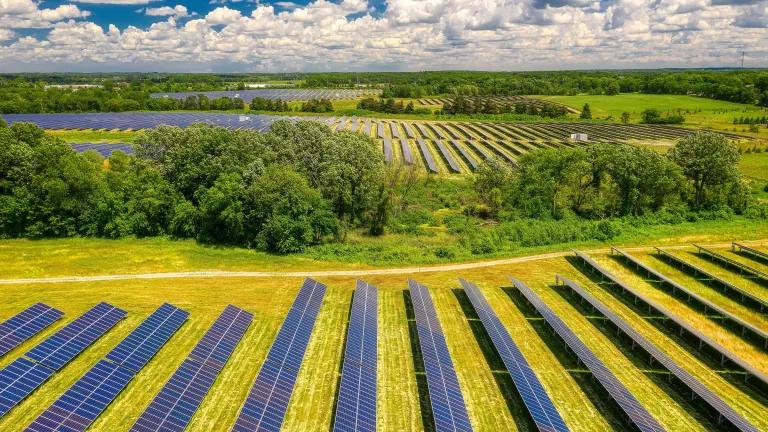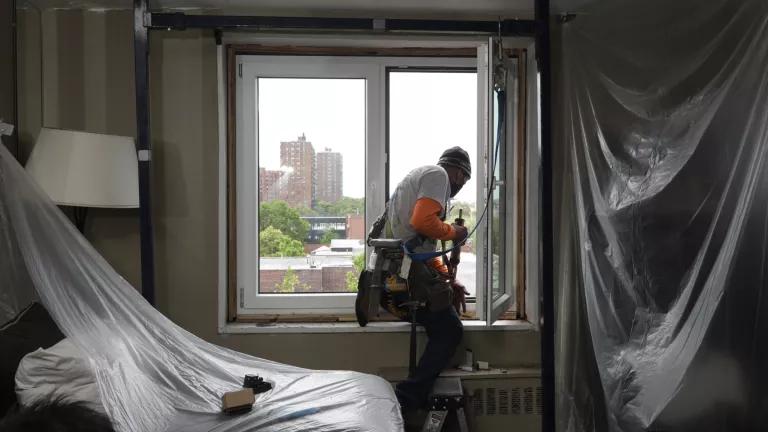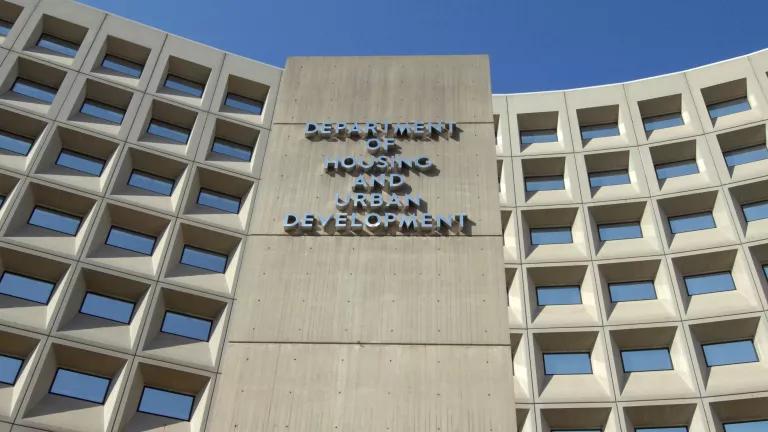The Inflation Reduction Act: What’s Now Possible
Here are the key elements of the sweeping climate, tax, and health care legislation that President Biden signed into law.
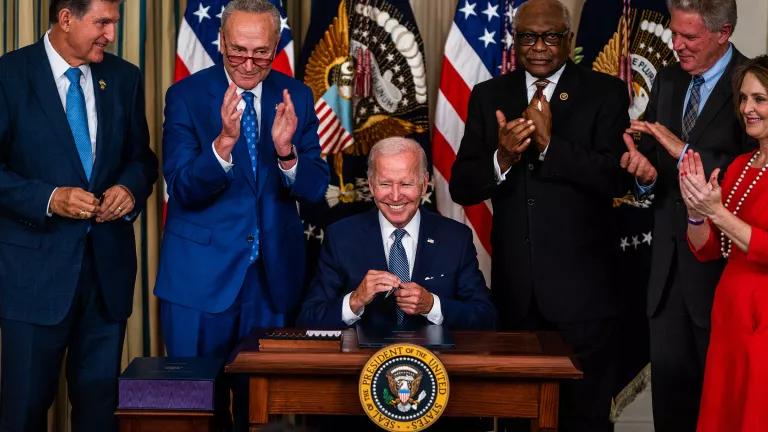
Here are the key elements of the sweeping climate, tax, and health care legislation that President Biden signed into law.
This week, President Joe Biden signed into law the strongest U.S. climate action ever, some $369 billion in strategic investments to drive the growth of clean energy and cut the nation’s carbon footprint. In signing the measure, Biden cast it as part of “a season of substance” for investing in progress that touches the lives of people across the country. That’s exactly what the Inflation Reduction Act will do.
It will create jobs, drive innovation, and strengthen the economy. It will make the country more secure, reducing U.S. dependence on the fossil fuels that fund belligerent petro-states. It provides significant investments for overburdened communities. It will help the United States begin to deliver on its global responsibility to cut climate pollution.
And, yes, it will help to fight inflation by reducing the deficit; driving down the cost of prescription drugs for seniors and of health care for low-income people; reducing household electricity bills by 8 percent or so; and curbing U.S. reliance on fossil fuels, the single-largest driver of inflation today.
This act also has challenged conventional thinking about what’s necessary and possible when it comes to addressing the needs of communities on the frontlines of climate hazard and fossil fuel harm. The $60 billion this legislation assigns to overburdened communities is historic. It’s also the minimum of what’s needed.
Further progress will be required, especially in light of provisions in the bill that support fossil fuels in ways that perpetuate inequities, inflicting disproportionate hazard and harm on low-income communities and people of color.
What will be important going forward is that the provisions of this act be implemented in a way that drives investment to the communities that need it most and ensures that frontline communities aren’t further burdened by additional fossil fuel pollution and climate danger.
Beyond that, President Biden should use his established authority to write rules and standards to help cut carbon pollution from our cars, trucks, and dirty power plants; cut methane emissions; and keep investors informed on corporate climate risk.
And we must strengthen, not weaken, the safeguards we all depend on to protect the environment and public health.
The strongest U.S. climate action ever
The Inflation Reduction Act calls for $369 billion in strategic investments, over 10 years, to help power companies generate more clean, low-cost electricity from the wind and sun. It funds climate-smart agriculture practices. It includes tax credits to make electric cars, new and used, more affordable for low-income and middle-income drivers. And it provides rebates and other incentives to cut the cost of installing energy-efficient appliances, heat pumps, and rooftop solar panels. All told, these measures can cut household utility bills by 8 percent or so, on average.
These and other incentives in the act will position the country to cut carbon pollution and other greenhouse gases by 40 to 41 percent below 2005 levels, as opposed to 30 percent without the act. Effective implementation will be essential to ensure that this new law achieves this kind of emissions cut.
That will make a solid down payment on the cuts of 50 to 52 percent Biden has pledged. But there’s much more for the Biden administration to do to get the rest of the way there.

A Cherry Street Energy crew installing rooftop solar panels at the Palisades Office Park in Atlanta, on June 24, 2021
Creating jobs, driving innovation, and strengthening the economy
The act will add hundreds of thousands of jobs, in red states and blue, to a clean energy sector that already employs 3.2 million workers nationwide at jobs paying 25 percent more, on average, than the median wage. Its 10-year horizon gives investors the clarity, certainty, and predictability they need to plan their future in the clean energy economy. And funding for grants, research, and federal procurement will help drive innovation—the seed corn for economic growth.
This will strengthen domestic manufacturing of clean energy equipment, like solar panels, electric vehicles, advanced batteries, and other building blocks of a low-carbon economy. And that, in turn, will help position workers and businesses across the country for success in a global clean energy market worth more than $920 billion a year—and rapidly growing.
Making the country more secure
Presidents going back to Richard Nixon have wrestled with this country’s dependence on oil. It has distorted U.S. diplomacy, drained national security resources, and led to tragic entanglements outside U.S. borders.
By speeding the shift to clean energy, the Inflation Reduction Act will strengthen U.S. security. By making our homes and workplaces more efficient, we’ll be able to do more with less waste, improving productivity and competitiveness. By helping to break U.S. dependence on the fuels that fund belligerent petro-states, we’ll stop padding the war chests of nations that threaten the interests of the United States and its partners and allies. By growing the production of renewable power generated here at home, we’ll invest in genuine energy security. And driving down emissions will give us a shot at reducing the security challenges created from withering drought, blistering heat, ravaging storms, wildfires, floods, and other impacts of climate change.

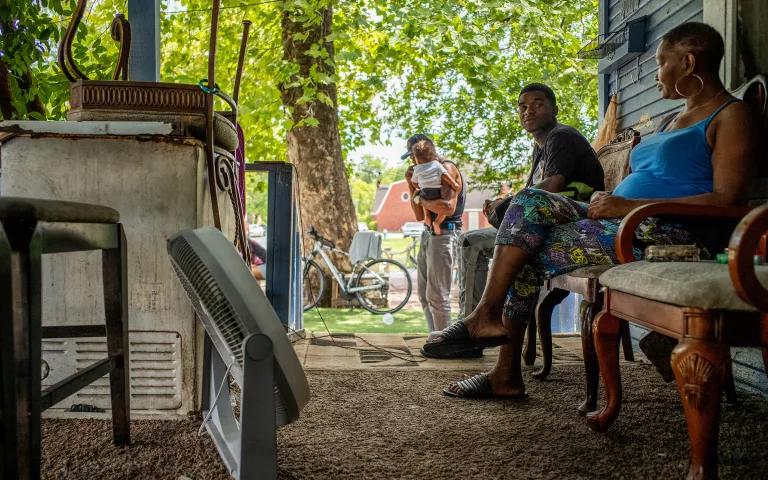
Helping families and communities become more resilient
Last month, nearly a third of the country simmered in the kind of extreme heat that poses dangerous health risks, especially to seniors, people with asthma or other respiratory ailments, and those whose jobs require them to work outside—on farms, roadways, construction sites, and elsewhere. Also at heightened risk: unsheltered people, low-income renters, and those who lack access to air-conditioned spaces or who can’t afford to run the air conditioners they have. Even more dangerous days are coming, with climate change driving a heartland heat belt that’s developing from Texas to Chicago and across much of the Southeast.
The Inflation Reduction Act provides billions of dollars to help people cope with the widening and increasingly dangerous heat. It includes rebates and tax credits to help put energy-efficient air conditioners and heat pumps within reach for lower-income households. It includes tax credits for homebuilders constructing high-efficiency multifamily housing. And it provides grants to help states and localities adopt and implement new building codes that encourage energy-efficient design.
While everyone can benefit from these incentives, many are larger for low-income households, which typically spend an above-average share of their income to pay their utility bills.
Helping the United States meet its global obligations
The United States has emitted more carbon pollution, over time, than any other country on earth. As the world’s leading contributor to the climate crisis, this country bears a clear obligation to cut its climate pollution and help the rest of the world to do the same. Currently, the United States is now second only to China in annual emissions. Addressing the climate crisis requires effective action from both countries.
Biden went to global climate talks in Glasgow last November, pledging to cut U.S. greenhouse gases by 50 to 52 percent below 2005 levels by 2030. When he attends the next round of talks this November in Sharm el-Sheikh, Egypt, he’ll bring substantive action to help the country deliver on that promise.
The challenge will be to build on that momentum and demonstrate how the United States will keep its climate promise, both by cutting its emissions and by providing urgently needed financial assistance for vulnerable populations in countries struggling to shift to clean energy and cope with the climate crisis. The United States has been falling woefully short on this needed investment in international climate action. Now the nation must step up—in a massive way—to help mobilize the kind of global action needed to tackle the climate crisis. “It’s destroying people’s lives and livelihoods—and doing it every single day,” Biden said last year in Glasgow. “It’s costing our nations trillions of dollars.”
The flaws
For all its strengths, this is not the climate bill NRDC would’ve written. It includes provisions that promote fossil fuels in ways that conflict with our climate aims—and our energy security.
Specifically, the bill links deployment of wind and solar projects to access to oil and gas drilling on federal lands and U.S. ocean waters. That provision has no place in a climate bill. It’s deeply problematic, and it will put some of the nation’s most vulnerable communities and ecosystems at needless risk.
The goal must be to break our dependence on fossil fuels and shift to energy sources that are cleaner, more sustainable, and more secure. Unfortunately, the bill contains some provisions that move us in the wrong direction. We will do everything we can to minimize the impact of these misguided provisions and mitigate the harm they cause.
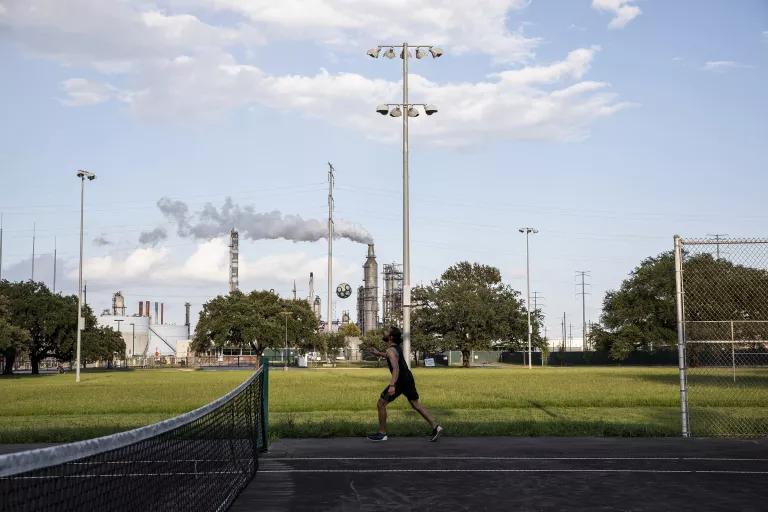
A soccer player practicing at Hartman Park in the Harrisburg/Manchester neighborhood of Houston beside the Valero Houston Refinery
What’s next
For starters, the provisions in the Inflation Reduction Act must be implemented in a way that delivers the most bang for the buck, in terms of reducing the carbon pollution and other greenhouse gases driving the climate crisis. They must be implemented so that targeted investments ripple throughout the economy and help create an even larger wave of climate action.
These measures must deliver benefits to the people who need them most in a way that prevents frontline communities from bearing additional burdens from fossil fuel hazard and climate harm. For far too long, low-income communities and people of color have suffered disproportionately from fossil fuels and all the damage and danger they bring. No one should have to accept additional burdens in exchange for economic and clean energy benefits. Investments to fight climate change must meet the administration’s Justice40 goals by addressing environmental injustice and spurring economic opportunity for disadvantaged communities.
And the Biden administration has work to do on the standards and safeguards front. Existing law provides Biden with extensive authority to write rules to help cut carbon pollution from the nation’s single-largest industrial source—power plants that burn coal and gas. They account for 25 percent of the nation’s greenhouse gas emissions. Nearly 8 in 10 Americans—about 78 percent—support federal limits on carbon pollution from power plants. The administration must use its authority to advance these rules with the urgency required.
Similarly, the administration is in the process of writing standards to help clean up tailpipe emissions from cars and trucks; reduce emissions of methane, a powerful greenhouse gas; improve the efficiency of buildings and appliances; safeguard the Tongass and other primary forests that absorb and store carbon from the atmosphere; protect workers from extreme heat; and ensure that investors stay abreast of corporate climate risk.
The administration must also implement the investments in the bipartisan infrastructure law in ways that help to cut the nation’s carbon footprint, not expand it; make roads, bridges, ports, and other critical infrastructure more resilient in the face of extreme weather; and help to protect vulnerable communities from fossil fuel pollution and climate dangers.
The Inflation Reduction Act provides powerful incentives to advance the climate fight. It is, though, very much the starting point, not the end, for the work to be done to confront the climate crisis, the existential challenge of our time.


